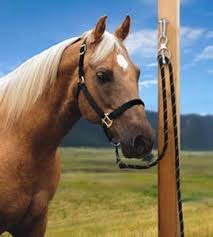Important Things to Remember When Tying Horses
 There are many factors to consider when tying a horse. It is important for many reasons to understand how a horse innately behaves and functions, especially for safety reasons when we handle them or ask them to do something that is not natural for them. Naturally horses are born as prey animals with strong flight responses. It is their primary means of survival. Mother Nature has innately taught them that they need to run first, think later. This is very important to know before we tie horses.
There are many factors to consider when tying a horse. It is important for many reasons to understand how a horse innately behaves and functions, especially for safety reasons when we handle them or ask them to do something that is not natural for them. Naturally horses are born as prey animals with strong flight responses. It is their primary means of survival. Mother Nature has innately taught them that they need to run first, think later. This is very important to know before we tie horses.
When a horse gets scared his first option is to run away and his only other option is to fight. An example of this would be if a horse got scared while being in crossties or was tied up. The crossties or tie restricts their movement, and if threatened it heightens their fear. They will do whatever is needed to flee an uncertain situation. If they can’t flee they will fight back and go against pressure rather than yield to it. It is an innate prey animal response. This might cause a horse to panic, scramble, or flip over backwards until they break free or until the horse feels unrestricted or unthreatened. Some people do not fully understand the possible outcomes of tying a horse or know how to teach a horse to tie properly. Unfortunately, if a horse pulls back and panics they can sometimes badly damage their neck, back, or other areas causing time off, treatment, and expensive visits from the massage therapist, chiropractor, or veterinarian might be needed. There have been many accidents happen with horses that have panicked while being tied. Some have damaged horses out of commission and some even fatalities.
 Over the years people have tried many different methods of tying. Some with success, but in some cases once a horse has learned to either break away by pulling harder, or has flipped over or hurt himself, they are not very comfortable with being tied again. The most successful chance of tying horses should start out with proper training. Rather than just tying a horse and see what will happen, teach them how to yield to pressure.
Over the years people have tried many different methods of tying. Some with success, but in some cases once a horse has learned to either break away by pulling harder, or has flipped over or hurt himself, they are not very comfortable with being tied again. The most successful chance of tying horses should start out with proper training. Rather than just tying a horse and see what will happen, teach them how to yield to pressure.
Great horsemen and trainers do this. They also use a great tool for teaching horses to tie called the Blocker Tie Ring. Even if a horse hasn’t been taught to yield to pressure the Blocker Tie Ring can give some comfort to the horse. It is designed to allow the horse to pull a small amount of slack in the lead rope through the tie ring to relieve his source of panic or sense of claustrophobia, preventing your horse from building up enough pressure to break tack or whatever he is tied to. The moment your horse stops pulling back, the pressure on his poll, neck and withers is released. This lets the horse figure out for himself that once he stops pulling back, the pressure is gone. Trainers love this tie ring because of the 3 different tying options: Mild, Medium, and Firm. One of the best features of the Blocker Tie Ring is the convenience of being able to take it where ever you go as needed from place to place. They are great for in your barn, crossties, inside and out of trailers, wash stalls, hitching posts, and even camping lines. They have become very popular when hauling horses due to the fact that if a trailer flipped over there would be enough give on the lead rope if needed to take a bit of pressure off horse's head position if he was hung up and wasnt accessable to help.
Everyone wants to do what is best for their horses. Safety and comfort for you and your horse should also be a priority. Proper training combined with the Blocker Tie Ring is a great way to feel comfortable and at ease when tying your best friend.

